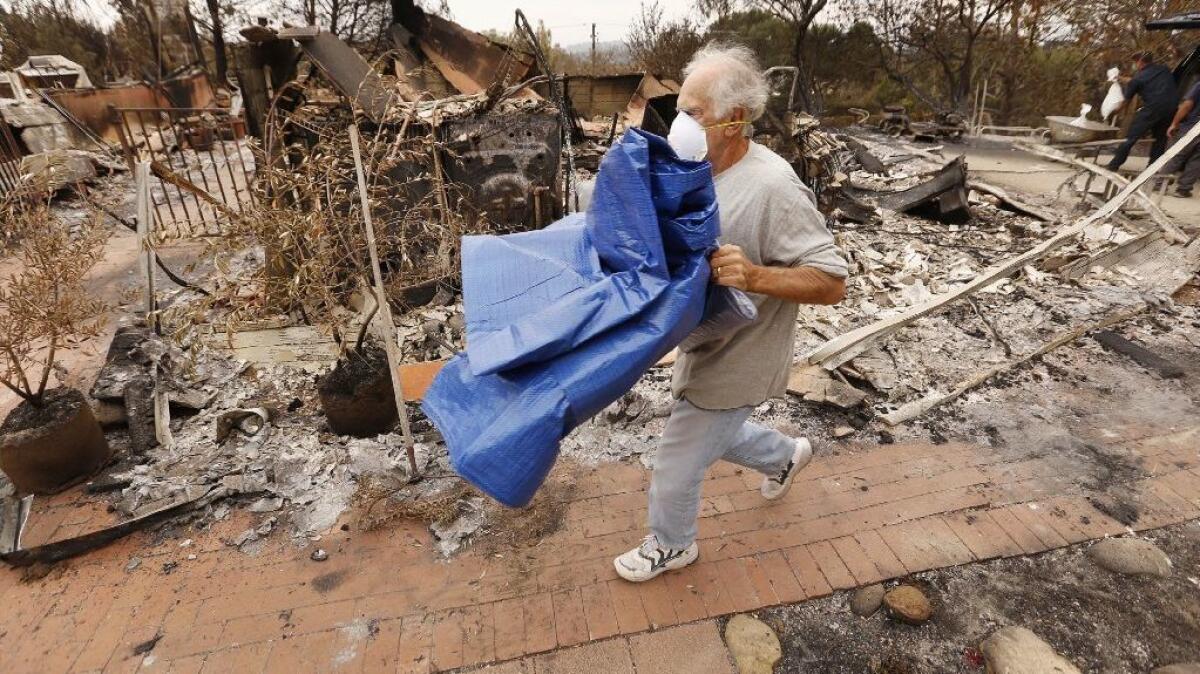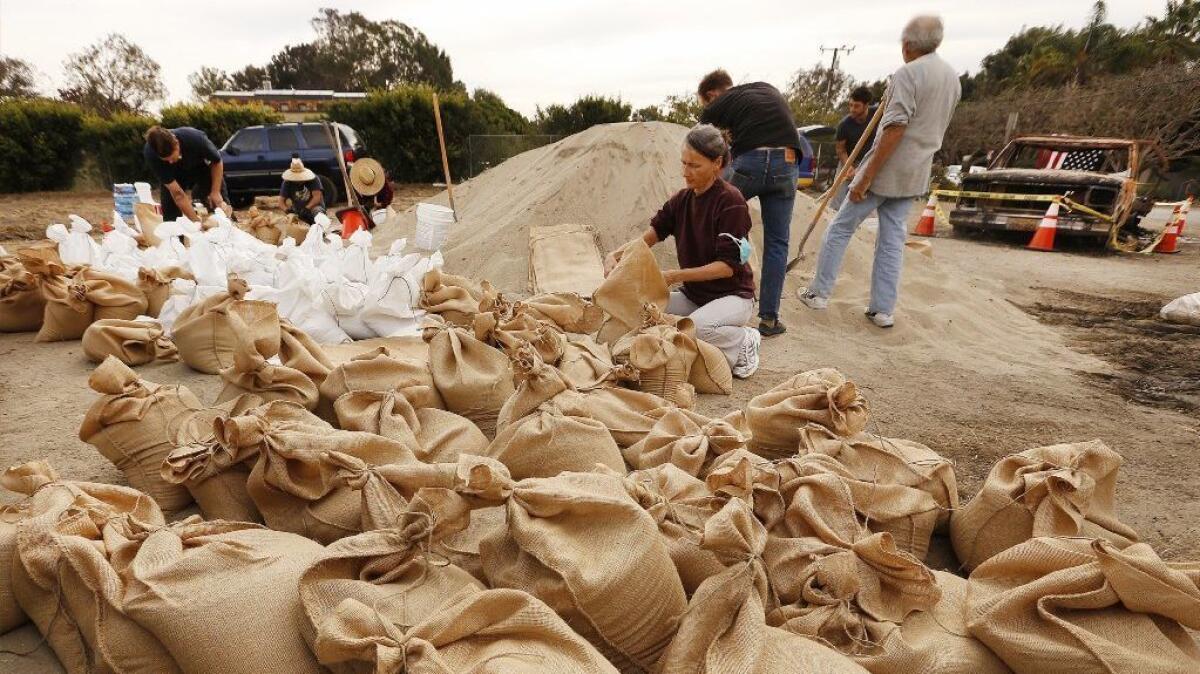Death toll rises as rain brings new dangers to California’s burn zones

Reporting from Chico, Calif. — Their blue and white, three-bedroom home was hidden on a Concow vineyard. It was cheery and bright with potted plants outside and a hammock strung between two trees.
For a while, the Duncan family had hope it survived. They had left a sprinkler running on its roof. But four days after they fled from the Camp fire, a friend texted them a photo of what was left of their home. Nothing.
Now, the Duncans, along with tens of thousands of others across the state reeling from the deadly wildfires that ravaged neighborhoods up and down California, are bracing this week for a possible second blow: flooding and mudslides from expected rain.
Butte County sheriff’s investigators, meanwhile, made progress finding people who have been reported missing. By Monday night, the number of people unaccounted for dropped from 993 to 699. Search crews scouring the devastation found two more bodies — one in a building in Paradise, the other outside in Magalia — raising the death toll from the blaze to 79.
Melissa Duncan and her husband went to Walmart to buy a large blue tarp and placed plastic under their new home, a donated tent pitched in the parking lot of the Glenn County Fairgrounds in Orland, in preparation for Wednesday’s storm.
“People are almost at their breaking point,” Duncan, 36, said about others staying at the fairgrounds. “Some days are harder than others. We’ll come out better for it, if only humbled.”
The National Weather Service issued a flash flood watch through Friday morning where the Camp fire raged through Butte County. While the rainfall will help with the firefight — the blaze is 70% contained and has burned 151,272 acres — neighborhoods that were destroyed, and those downstream of them, could see mudslides and debris flows.
The Camp fire burn zone could see up to 6 inches of rain through Saturday, which isn’t unusual for that region, said Johnnie Powell, a meteorologist with the National Weather Service in Sacramento. In April, Paradise saw nearly 6 inches of rain in one day in what was its last significant storm.
“Best-case scenario, it’ll rain on it and nothing will move. Worst-case scenario, the mud will start moving,” Powell said. “We just have to wait and see what happens. All we know for sure is, it’s going to rain really hard.”
The soil in recently burned areas cannot absorb rainwater. Enough rain can lead to fast-moving flows of mud, debris and even trees and boulders that can be deadly for those in their path. The devastation often comes without warning.
LIVE UPDATES: The latest on the California wildfires »

In Southern California, the Woolsey fire burn area is expected to see between half an inch to an inch of rain late Wednesday into early Thursday. Showers could linger into Thursday morning, said David Sweet, a meteorologist with the National Weather Service in Oxnard.
Authorities have pointed to the deadly debris flow that hit Montecito after the Thomas fire last year in asking residents to be vigilant.
“I don’t want you to think we can stop floods if it rains. Floods will occur,” Chief Thom Porter of the California Department of Forestry and Fire Protection said at a town hall meeting. “Much like Montecito, the orders will be ‘evacuate,’ and you need to evacuate if you get that.”
At a shelter at East Ave Church in Chico, donors brought gravel and paved over an acre of grass so that fire refugees could pitch their tents on dry ground and not grass that would get wet and muddy.
At another shelter about 30 miles away in Gridley, hot meals are served, snacks and water are readily available, as are toiletries, and American Red Cross volunteers are on hand to help with questions.
Deadly California fires prompt bold thinking about prevention »
The Thompsons live at the end of a row of green cots, distinguished only by the plastic tubs filled with donated clothes and shoes that fit various members of a family of five. The generosity of strangers has been overwhelming.
“We’re having to turn stuff away,” said Melissa Thompson. “Someone handed me a $100 bill, and she lost her own home.”
But the 38-year-old mother has grown restless. The relief she felt the first week from having a place to stay has shifted to an uneasiness about the future. She’d like to find out if her apartment complex in Magalia survived. If it didn’t, she needs to figure out where her family will live next.
“The unknown is the worst part,” said Thompson, who is legally blind and on disability.
In Butte Creek Canyon, Calvin Daley cleaned out the drains and other waterways around his home, which was spared from the blaze. He worries for people who lost their homes, those living in tents. He wishes it were summer.
“It’s cold, winter is setting in and it’s going to be wet,” he said. “If it’s going to be a wet winter, we have a long ride ahead of us.”
Daley, 66, sat on the front porch of his two-story home listening to jazz on a battery-operated radio. Birds hopped from burned branches of a pine tree to a feeder.
He never evacuated; he stayed behind to save his home with three hoses. Standing near his long driveway, he paused and rubbed his chin.
“Sometimes I feel guilty,” he said. “Why do I deserve this? Why did I pull this off? How many people wanted this chance to save their home?”
Knoll and Vives reported from Chico, Tchekmedyian from Los Angeles. Times staff writer Hannah Fry in Los Angeles contributed to this report.
More to Read
Sign up for Essential California
The most important California stories and recommendations in your inbox every morning.
You may occasionally receive promotional content from the Los Angeles Times.













